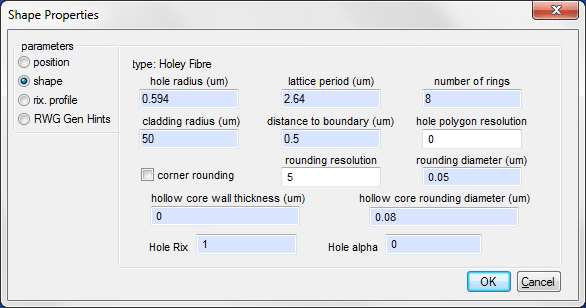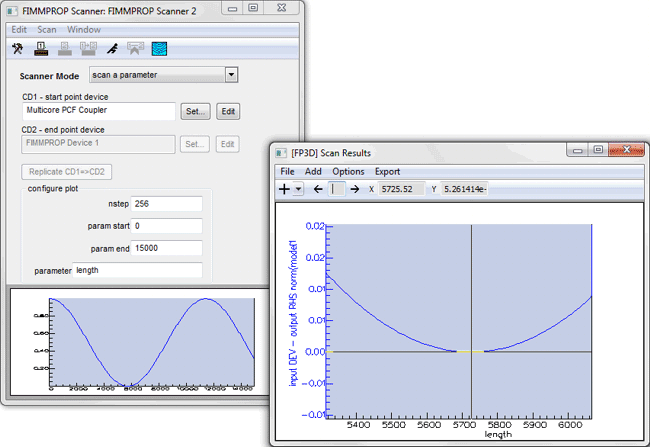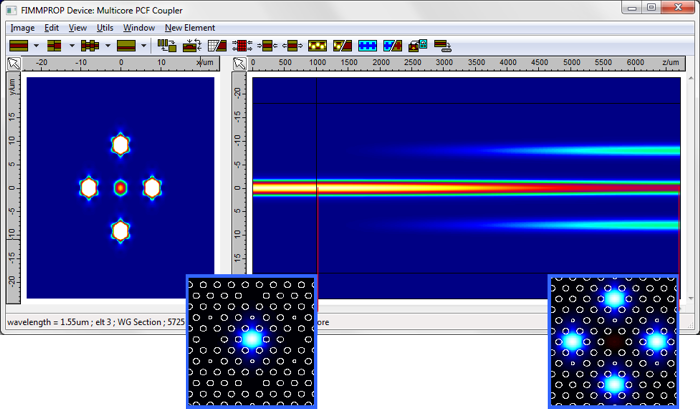FIMMPROPA bi-directional optical propagation tool |
   |
Multicore Photonic-Crystal Fiber 1x4 Power SplitterSimulations with FIMMPROP softwareWe have used FIMMWAVE and FIMMPROP to determine the characteristics of a 1x4 power splitter based on a multicore photonic crystal fiber (PCF). This simulation is an excellent example of the strength of FIMMPROP's modal approach: rigorous fully vectorial 3D results can be obtained here within a few seconds, where approaches based on BPM, FDTD or FEM methods would be extremely inefficient. The five-core design is created by introducing a central core (lattice defect) in a hexagonal photonic crystal fiber and four additional cores positioned as shown below. In order to improve the coupling between the cores, the diameter of the holes above and below each core was modified. The original design is described in [1].
We used a pitch of 2.64um, the large holes had a diameter of 0.45*pitch and the small holes a diameter of 0.23*pitch. The fiber was optimised for a wavelength of 1.55um. For the design we relied on FIMMWAVE's pre-defined photonic crystal fiber shape, which allows users to remove individual holes and to modify their radius.
We used FIMMWAVE's finite-element solver - the FEM Solver - to calculate the modes of the fiber. The FEM Solver was able to take advantage of the symmetry of the structure and was found to converge very quickly. The FEM Solver is ideal in this case as its adaptive triangular mesh can adapt itself to virtually any arbitrary shape. You can see the a few modes of this multicore fiber below. The size of the cladding was reduced in order to speed up calculations.
The coupler is created by coupling light into the multicore PCF from a single-core PCF of similar dimensions. The calculation was made in FIMMPROP and the coupling length was optimised using a FIMMPROP Scanner to vary the length of the multicore section. We added another section of single-mode PCF at the end of the device to measure the power remaining in the central core at the end of the coupling length.
The results of the scanner are shown below. The simulation was extremely fast: the initial calculation for a single length took under ten seconds on a 4-core i7-2600 CPU. This is for a fully vectorial 3D simulation! Scanning the length was quasi-instantaneous; this is because FIMMPROP only recalculates what is needed when modifying a design. In comparison if you were to try to model this with an 3D FEM or FDTD calculator it would take you a few days to simulate just one length!
We found total coupling to the four output ports for a length of 5725um, which matches the expected result of 5.8mm (from [1]). You can find the resulting intensity profile in the YZ plane as well as the field profiles at the input and output in the picture below.
ReferenceS. K. Varshney, K. Saitoh, R. K. Sinha and M. Koshiba, "Coupling Characteristics of Multicore Photonic Crystal Fiber-Based 1 x 4 Power Splitters", Journal of Lightwave Technology, 27, 12, pp. 2062-2068 (2009)
|









